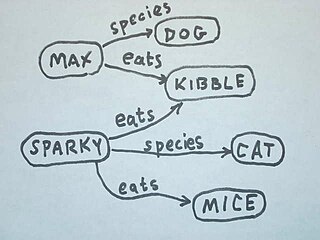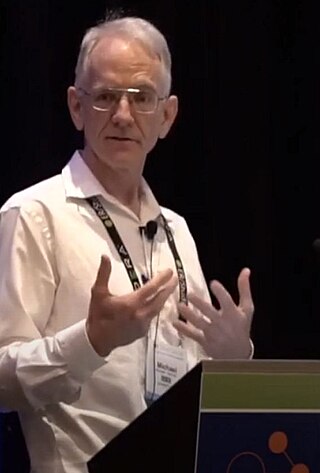
The Semantic Web, sometimes known as Web 3.0, is an extension of the World Wide Web through standards set by the World Wide Web Consortium (W3C). The goal of the Semantic Web is to make Internet data machine-readable.
In information science, an ontology encompasses a representation, formal naming, and definitions of the categories, properties, and relations between the concepts, data, or entities that pertain to one, many, or all domains of discourse. More simply, an ontology is a way of showing the properties of a subject area and how they are related, by defining a set of terms and relational expressions that represent the entities in that subject area. The field which studies ontologies so conceived is sometimes referred to as applied ontology.

Deborah Louise McGuinness is an American computer scientist and researcher at Rensselaer Polytechnic Institute (RPI). She is a professor of Computer, Cognitive and Web Sciences, Industrial and Systems Engineering, and an endowed chair in the Tetherless World Constellation, a multidisciplinary research institution within RPI that focuses on the study of theories, methods and applications of the World Wide Web. Her fields of expertise include interdisciplinary data integration, artificial intelligence, specifically in knowledge representation and reasoning, description logics, the semantic web, explanation, and trust.

Barry Smith is an academic working in the fields of ontology and biomedical informatics. Smith is the author of more than 700 scientific publications, including 15 authored or edited books. He is one of the most widely cited living philosophers.

The ultimate goal of semantic technology is to help machines understand data. To enable the encoding of semantics with the data, well-known technologies are RDF and OWL. These technologies formally represent the meaning involved in information. For example, ontology can describe concepts, relationships between things, and categories of things. These embedded semantics with the data offer significant advantages such as reasoning over data and dealing with heterogeneous data sources.

Rudi Studer is a German computer scientist and professor emeritus at KIT, Germany. He served as head of the knowledge management research group at the Institute AIFB and one of the directors of the Karlsruhe Service Research Institute (KSRI). He is a former president of the Semantic Web Science Association, an STI International Fellow, and a member of numerous programme committees and editorial boards. He was one of the inaugural editors-in-chief of the Journal of Web Semantics, a position he held until 2007. He is a co-author of the "Semantic Wikipedia" proposal which led to the development of Wikidata.

Enterprise modelling is the abstract representation, description and definition of the structure, processes, information and resources of an identifiable business, government body, or other large organization.
Douglas Taylor "Doug" Ross was an American computer scientist pioneer, and chairman of SofTech, Inc. He is most famous for originating the term CAD for computer-aided design, and is considered to be the father of Automatically Programmed Tools (APT), a programming language to drive numerical control in manufacturing. His later work focused on a pseudophilosophy he developed and named Plex.

The TOVE project is a project to develop an ontological framework for enterprise integration (EI) based on and suited for enterprise modeling. In the beginning of the 1990s it was initiated by Mark S. Fox and others at the University of Toronto.
Amit Sheth is a computer scientist at University of South Carolina in Columbia, South Carolina. He is the founding Director of the Artificial Intelligence Institute, and a Professor of Computer Science and Engineering. From 2007 to June 2019, he was the Lexis Nexis Ohio Eminent Scholar, director of the Ohio Center of Excellence in Knowledge-enabled Computing, and a Professor of Computer Science at Wright State University. Sheth's work has been cited by over 48,800 publications. He has an h-index of 106, which puts him among the top 100 computer scientists with the highest h-index. Prior to founding the Kno.e.sis Center, he served as the director of the Large Scale Distributed Information Systems Lab at the University of Georgia in Athens, Georgia.

A semantic data model (SDM) is a high-level semantics-based database description and structuring formalism for databases. This database model is designed to capture more of the meaning of an application environment than is possible with contemporary database models. An SDM specification describes a database in terms of the kinds of entities that exist in the application environment, the classifications and groupings of those entities, and the structural interconnections among them. SDM provides a collection of high-level modeling primitives to capture the semantics of an application environment. By accommodating derived information in a database structural specification, SDM allows the same information to be viewed in several ways; this makes it possible to directly accommodate the variety of needs and processing requirements typically present in database applications. The design of the present SDM is based on our experience in using a preliminary version of it. SDM is designed to enhance the effectiveness and usability of database systems. An SDM database description can serve as a formal specification and documentation tool for a database; it can provide a basis for supporting a variety of powerful user interface facilities, it can serve as a conceptual database model in the database design process; and, it can be used as the database model for a new kind of database management system.
BORO is an approach to developing ontological or semantic models for large complex operational applications that consists of a top ontology as well as a process for constructing the ontology. It was originally developed as a method for mining ontologies from multiple legacy systems – as the first stage in an architectural transformation or software modernization. It has also been used to enable semantic interoperability between legacy systems. It is described in detail in. It is the analysis method used in the development and maintenance of the U.S. Department of Defense Architecture Framework (DoDAF) Meta Model (DM2), where a data modeling working group of over 350 members was able to systematically resolve a broad spectrum of knowledge representation issues.

In computer science, information science and systems engineering, ontology engineering is a field which studies the methods and methodologies for building ontologies, which encompasses a representation, formal naming and definition of the categories, properties and relations between the concepts, data and entities of a given domain of interest. In a broader sense, this field also includes a knowledge construction of the domain using formal ontology representations such as OWL/RDF. A large-scale representation of abstract concepts such as actions, time, physical objects and beliefs would be an example of ontological engineering. Ontology engineering is one of the areas of applied ontology, and can be seen as an application of philosophical ontology. Core ideas and objectives of ontology engineering are also central in conceptual modeling.
François B. Vernadat is a French and Canadian computer scientist, who has contributed to Enterprise Modelling, Enterprise Integration and Networking over the last 40 years specialising in Enterprise Architectures, business process modelling, information systems design and analysis, systems integration and interoperability and systems analysis using Petri nets.
The Semantic Sensor Web (SSW) is a marriage of sensor web and semantic Web technologies. The encoding of sensor descriptions and sensor observation data with Semantic Web languages enables more expressive representation, advanced access, and formal analysis of sensor resources. The SSW annotates sensor data with spatial, temporal, and thematic semantic metadata. This technique builds on current standardization efforts within the Open Geospatial Consortium's Sensor Web Enablement (SWE) and extends them with Semantic Web technologies to provide enhanced descriptions and access to sensor data.
Mark Stephen Fox is a Canadian computer scientist, Professor of Industrial Engineering and Distinguished Professor of Urban Systems Engineering at the University of Toronto, known for the development of Constraint Directed Scheduling in the 1980s and the TOVE Project to develop an ontological framework for enterprise modeling and enterprise integration in the 1990s.

Michael F. Uschold is an American computer scientist, Artificial Intelligence researcher, and consultant known for his work on knowledge representation and ontology.
David S. Frankel is an American Information Technology expert and consultant, known for his work on model-driven engineering and semantic information modeling.

Hussein S. M. Zedan was a computer scientist of Egyptian descent, mainly based in the United Kingdom.

Michael (Mike) Papazoglou is a Greek/Australian emeritus professor, computer science researcher and author known for his contributions to 'Service-Oriented Computing'. His main research interests include Distributed computing, Database#Database management system, Big data, Service, Domain-specific language and Cloud computing. In more recent years he shifted his focus to pursuing Emerging technologies, Industrial engineering, Smart Applications and Smart Technology Solutions for Healthcare and Manufacturing.












